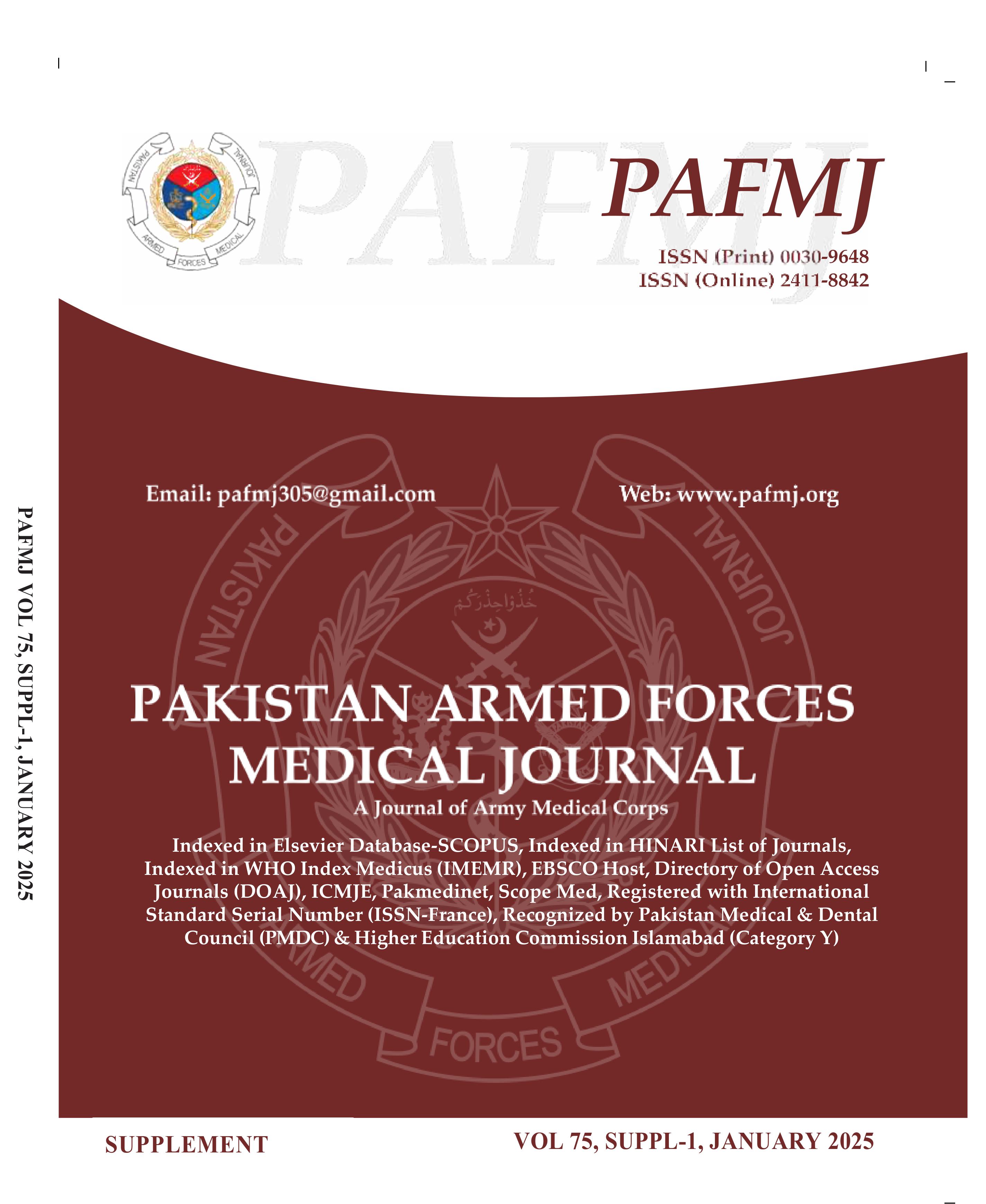Comparison of Manual Fetal Stimulation vs. No Fetal Stimulation on Non-Reassuring CTG during Intrapartum Fetal Surveillance
DOI:
https://doi.org/10.51253/pafmj.v75iSUPPL-1.12416Keywords:
Apgar Score, Cardiotocography CTG, Caesearen, Cord Blood Lactate, Manual Fetal Stimulation, Non-Reassuring.Abstract
Objective: To compare the effectiveness of manual fetal stimulation versus no fetal stimulation in managing non-reassuring Cardiotocography during intrapartum fetal surveillance.
Study Design: Quasi-experimantal study
Place and Duration of Study: Department of Obstetrics & Gynaecology, Pak Emirates Military Hospital, Rawalpindi Pakistan from Jan 2023 to Mar 2024.
Methodology: In this study, n=242 patients were allocated randomly to either the manual fetal stimulation and Cardiotocography group or the no fetal stimulation and Cardiotocography group. The Inclusion criteria were women with singleton pregnancy at a gestation length of 37 weeks or more with non-reassuring Cardiotocography findings. The main parameters studied were the fetal heart accelerations, mode of delivery, Apgar score at the fifth minute, cord blood lactate level and admission to the neonatal intensive care unit.
Results: Significantly higher number of patients (94.22%) showed fetal heart acceleration in the manual fetal stimulation group as compared to the no fetal stimulation group (80.17%). In the manual fetal stimulation group, 31.40% of the women underwent caesarean delivery compared to 37.19% in the no fetal stimulation group; however, the difference was not significant. Apgar score at 5th minute, cord blood lactate level and number of babies admitted to neonatal intensive care unit was also not different between the groups (p>0.05).
Conclusion: Significantly higher number of cases having non-reassuring Cardiotocography showed the acceleration in fetal heart rate in response to manual fetal stimulation as compared to those not given this treatment. However, maternal and fetal outcomes were not different between the treatments.
Downloads
References
Al Wattar BH, Honess E, Bunnewell S, Welton NJ, Quenby S, Khan KS. Effectiveness of intrapartum fetal surveillance to improve maternal and neonatal outcomes: a systematic review and network meta-analysis. Cmaj 2021; 193(14): E468-E477.
https://doi.org/10.1503/cmaj.202538
Gravett C, Eckert LO, Gravett MG, Dudley DJ, Stringer EM, Mujobu TBM. Non-reassuring fetal status: case definition & guidelines for data collection, analysis, and presentation of immunization safety data. Vaccine 2016; 34(49): 6084.
https://doi.org/10.1016/j.vaccine.2016.03.043
Rathore AM, Ramji S, Devi CB, Saini S, Manaktala U, Batra S. Fetal scalp stimulation test: an adjunct to intermittent auscultation in non-reassuring fetal status during labor. J Obs Gynaecol Res 2011; 37: 819–824.
https://doi.org/10.1111/j.1447-0756.2010.01442.
Murphy DJ, Devane D, Molloy E, Shahabuddin Y. Fetal scalp stimulation for assessing fetal well‐being during labour. Cochrane Database Syst Rev 2023(1).
https://doi.org/10.1002/14651858.CD013808.pub2
Alfirevic Z, Gyte GM, Cuthbert A, Devane D. Continuous cardiotocography (CTG) as a form of electronic fetal monitoring (EFM) for fetal assessment during labour. Cochrane Database Syst Rev 2017(2).
https://doi.org/10.1002/14651858.CD006066.pub3
Paladugu V, Sreedhar S, Chitra R, Mannava ST, Sreekumar S, Mangalakanthi J. Association of CTG diagnosis of intrapartum fetal distress and immediate postpartum acidemia in Foetal umbilical artery. J Obstetrics Gynecol India 2023; 73(1): 28-35.
https://doi.org/10.1007/s13224-022-01702-2
Ayres-de-Campos D, Spong CY, Chandraharan E. FIGO consensus guidelines on intrapartum fetal monitoring: Cardiotocography. Int J Gynecol Obstet 2015; 131(1): 13-24.
https://doi.org/10.1016/j.ijgo.2015.06.020
Tan KH, Sabapathy A, Wei X. Fetal manipulation for facilitating tests of fetal wellbeing. Cochrane Database Syst Rev 2013(12).
https://doi.org/10.1002/14651858.CD003396.pub2
Macones GA. Intrapartum fetal heart rate monitoring: nomenclature, interpretation, and general management principles. Obstet Gynecol 2009; 114(1): 192-202.
https://doi.org/10.1097/AOG.0b013e3181aef106
Cnattingius S, Johansson S, Razaz N. Apgar score and risk of neonatal death among preterm infants. New Engl J Med 2020; 383(1): 49-57. https://doi.org/10.1056/NEJMoa1915075
Gjerris AC, Stær-Jensen J, Jørgensen JS, Bergholt T, Nickelsen C. Umbilical cord blood lactate: a valuable tool in the assessment of fetal metabolic acidosis. Eur J Obstet Gynecol Reprod Biol 2008; 139(1): 16-20. https://doi.org/10.1016/j.ejogrb.2007.10.004
Tuuli MG, Stout MJ, Shanks A, Odibo AO, Macones GA, Cahill AG. Umbilical cord arterial lactate compared with pH for predicting neonatal morbidity at term. Obstet Gynecol 2014; 124(4): 756-761.
https://doi.org/10.1097/AOG.0000000000000466
Wirawit Piyamongkol M, Trungtawatchai S, Chanprapaph P, Tongsong T. Comparison of the manual stimulation test and the nonstress test: a randomized controlled trial. J Med Assoc Thai 2006; 89(12): 1999-2002.
https://pubmed.ncbi.nlm.nih.gov/17214048
Shakouri F, Iorizzo L, Edwards HMK, Vinter CA, Kristensen K, Isberg P-E. Effectiveness of fetal scalp stimulation test in assessing fetal wellbeing during labor, a retrospective cohort study. BMC Pregnancy and Childbirth 2020; 20: 1-7.
https://doi.org/10.1186/s12884-020-03030-7
Tahir Mahmood U, O’Gorman C, Marchocki Z, O’Brien Y, Murphy DJ. Fetal scalp stimulation (FSS) versus fetal blood sampling (FBS) for women with abnormal fetal heart rate monitoring in labor: a prospective cohort study. J Matern Fetal Neonatal Med 2018; 31(13): 1742-1747.
https://doi.org/10.1080/14767058.2017.1326900
Skupski DW, Rosenberg CR, Eglinton GS. Intrapartum fetal stimulation tests: a meta-analysis 1. Obstet Gynecol 2002; 1(99): 129-134. https://doi.org/10.1016/S0029-7844(01)01645-3
Druzin ML, Gratacos J, Paul RH, Broussard P, McCart D, Smith M. Antepartum fetal heart rate testing: XII. The effect of manual manipulation of the fetus on the nonstress test. Am J Obstet Gynecol 1985; 151(1): 61-64.
https://doi.org/10.1016/0002-9378(85)90425-9.
Hughes O, Murphy D. Comparing second-line tests to assess fetal wellbeing in Labor: a feasibility study and pilot randomized controlled trial. J Matern Fetal Neonatal Med. 2022; 35(1): 91-99. https://doi.org/10.1080/14767058.2020.1712704
Tahmina S, Daniel M, Krishnan L. Manual fetal stimulation during intrapartum fetal surveillance: a randomized controlled trial. Am J Obstet Gynecol MFM 2022; 4(2): 100574.
Downloads
Published
Issue
Section
License
Copyright (c) 2025 Arwa Fatima, Tehreem Yazdani, Shazia Firdos Chohan, Rabiah Anwar, Mafia Toheed, Taimur Azam Khan

This work is licensed under a Creative Commons Attribution-NonCommercial 4.0 International License.















